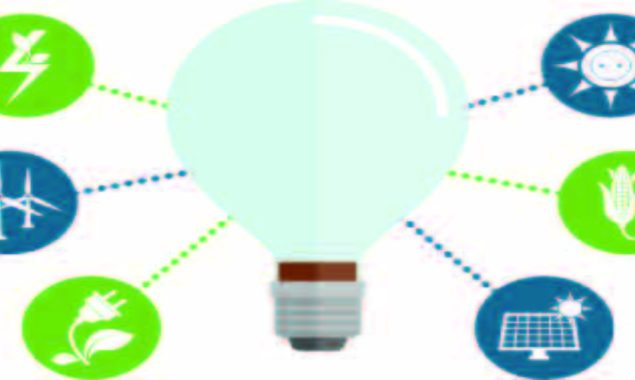
KARACHI: Pakistan is facing a severe energy crisis that has affected all the sectors of the economy, with parts of the country experiencing unannounced hours long power outages on a daily basis.
The country generates its power from an energy mix that includes oil, natural gas and liquefied natural gas (LNG), coal, renewable resources, including solar, wind and hydro energy, nuclear, and biomass.
The total installed power generation capacity is 38,700MW, whereas renewables contribute only 4 per cent, while 57 per cent of the energy comes from thermal fossil fuels, 31 per cent from hydro, and 8 per cent from nuclear, according to the National Electric Power Regulatory Authority’s (Nepra) 2020 yearly report.
Even though Pakistan has a tremendous amount of potential to generate solar and wind power, it is utilising just 0.071 per cent of the country’s area for solar photovoltaic (PV) power generation, according to the World Bank data.
Wind is also an abundant resource. Pakistan has several well-known wind corridors and average wind speeds of 7.87 m/s in 10 per cent of its windiest areas.
However, despite a number of successful projects, the installed capacity of solar and wind energy in Pakistan, of over 1,500MW, is 4 per cent of the total capacity, equal to around 2 per cent of the total generation.
Optimus Capital Management Pvt Ltd Executive Chairman Asif Qureshi said that adding renewable energy resources to the main grid of the country depends on the advancement and price decline in the allied products to store the generated energy.
“The biggest concern for reliance on renewable energy is the variable factors, as the wind and solar cannot be directly stored or stockpiled and whose availability is difficult to predict,” he added.
“The technology to store the renewable energy is not much developed in the country and the available technology is much expensive for Pakistan to add renewable energy to the national grid.”
“The grid capacity is another factor to account for, as there are not many technologies to transit the generated renewable energy to the grid,” Qureshi said.
Talking about the government’s plan to produce 60 per cent clean energy by 2030, he said, “Although the plan is looking quite an ambitious one but it is possible to achieve if the technology to produce, store and transit the renewable energy becomes advanced and cheaper than other means of producing energy.”
“Hydropower plays a huge role in Pakistan’s power generation, as it accounts for around 30 per cent of the total energy generation. Even though it does not fall in the category of renewable and clean energy, the low greenhouse gases emission in its generation coupled with the future technological advancement in storing and supplying of renewables could help the country achieve its plan to produce 60 per cent of clean energy by 2030,” he said.
Pakistan is among the top 10 countries worldwide suffering the largest damages from the climate-related disasters since 2000, highly affected by climate change, while only contributing around one per cent to the global greenhouse gas emissions (GHG), a report by International Monetary Fund (IMF) showed.
The country has experienced increase in temperatures, fluctuating levels of precipitation, and extreme climate shocks, according to the IMF’s 2021 Article IV consultation and staff report on the sixth review.
Over the past two decades, 120 recorded events have caused an estimated $22 billion in material damages, left more than 55 million people affected and 11,000 killed globally, the document showed.
Pakistan is experiencing many adverse effects because of climate change and it still is expanding its domestic lignite production to replace the costly fuel imports that are bearing down on its foreign exchange reserves.
However, burning lignite is said to be more polluting than other fuels, undermining the country’s efforts to bring in policies to address climate change.
With the work on the third phase of the Thar Coal Block II mine expansion is set to begin this year at an estimated cost of $93 million, according to the Sindh Engro Coal Mining Company (SECMC), a public-private enterprise operating the mine since 2019 in the southeastern district of Tharparkar, the country is stepping up its efforts to tap the coal resources as much as it can.
The second phase of expansion is under way with the help of China Machinery Engineering Corp and Chinese bank loans, in addition to local financing.
The series of expansions will scale up the annual production of lignite from 3.8 million tonnes to 12.2 million tonnes by 2023.
The output from the second phase of expansion will feed two 330MW coal-fired power plants being built under the $50 billion China-Pakistan Economic Corridor (CPEC) projects. The power plants are expected to come online this year.
Garbagecan (Pvt) Ltd Founder and Chief Executive Officer Ahmad Shabbar said: “The increasing dependence on the coal for power generation is a big threat to the environment of the country, as burning coal release toxic chemicals, poisonous dust and other harmful chemicals in the air.”
“Pakistan’s shift towards coal for power generation is mainly due to the easy access and the abundance of coal, especially in the Thar region. The country has a big opportunity to process the waste into power but it seems that there is not much interest from the authorities in this regard.”
“When the world is transitioning to clean energy and stepping up its measures to reduce greenhouse gases emission, we are increasing our carbon footprint by burning coal to produce energy, which will have drastic impact on the overall climate of the country.”
“The droughts, smog, acid rain and the increasing periods of summer have been witnessed in the country and around the world, with Pakistan experiencing drastic and sudden changes in the weather pattern. We need to shift towards clean energy to reduce our carbon footprints,” Shabbar added.
The country, on the one hand, is unable to keep up with the rising power demand and, on the other, it is levying taxes on allied products of solar panels, including inverters and batteries.
The government through the Finance (Supplementary) Bill, 2021, levied sales tax on nearly 150 items, including solar panels, to meet one of the conditions of the International Monetary Fund (IMF) for the revival of a $6 billion loan programme.
Earlier, Lahore Chamber of Commerce and Industry President Mian Nauman Kabir had said that the imposition of tax will damage the efforts of promoting alternative energy resources in the country.
“The world is setting targets for a zero-carbon economy, supporting the trade of green products and imposing penalties on the high carbon sector. The Imposition of tax on solar energy equipment is not a good idea,” Kabir added.
The decision was contrary to the objectives of the Alternate and Renewable Energy Policy, he said, adding that solar energy would be costly due to the increased taxes.
In January, Pakistan Solar Association (PSA) Vice Chairman Naveed Karar said the prices of solar panels will be raised after imposition of tax.
“After the implementation of this tax, the price of solar panels will increase from Rs55/watt to Rs70/watt. This is almost a 30 per cent surge.”
The Board of Executive Directors of the World Bank in June 2021 approved $800 million to finance the Pakistan Programme for Affordable and Clean Energy (PACE) and the Securing Human Investments to Foster Transformation (SHIFT).
The $400 million PACE project was aimed at focusing on the measures to improve the financial viability of the power sector and support the country’s transition to low-carbon energy.
The $400 million SHIFT-II programme was aimed at supporting a federal structure to strengthen basic service delivery for human capital accumulation. The programme will help improve the health and education services, increase income generation opportunities for the poor and promote inclusive economic growth, a statement said.
Read More News On
Catch all the Business News, Breaking News Event and Latest News Updates on The BOL News
Download The BOL News App to get the Daily News Update & Follow us on Google News.




